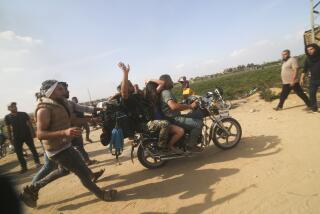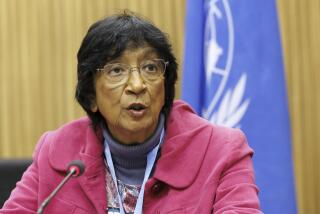Civilian Deaths, Executions Found in Afghan Fighting
- Share via
KABUL, Afghanistan — The United Nations has revealed that factional fighting in northwestern Afghanistan in March led to a string of killings that may have been the bloodiest series of human rights abuses since the end of the war on the Taliban regime and the Al Qaeda terrorists it harbored.
A U.N. team found that a string of clashes, slayings and lootings that began March 24 in Badghis province claimed 38 civilian lives. In addition, 26 combatants were executed, the investigators said, and found with their hands tied behind their backs. The deaths were concentrated in the village of Akazi.
In an unusually critical statement Sunday, the U.N. urged local police and the Badghis governor appointed by President Hamid Karzai to “arrest the perpetrators and bring them to justice, as well as take all other necessary measures to prevent the recurrence of similar events.”
Until the mission visited Badghis from April 16 to 20, the U.N. and local human rights officials had only a “vague idea” of the violence that had gripped the remote province bordering Turkmenistan, spokesman David Singh said Sunday.
The province is regarded as especially turbulent because it sits astride opium transit routes into Turkmenistan.
“The remoteness of the area often makes it impossible for these people to address complaints to the central government,” the U.N. statement said.
Factional violence has been rising in recent weeks across this nation. It is typically caused by friction among ethnic groups or between rival warlords and their subcommanders.
Remnants of the Taliban and Al Qaeda also continue to attack and harass U.S. Army bases and patrols along the Pakistani border.
Earlier this month, factional fighting in Faryab and Samangan provinces claimed 21 lives and prompted the U.S. military to send aircraft over the sites to discourage the fighting. In those cases, the violence was caused by conflict between local commanders loyal to rival warlords Abdul Rashid Dostum and Atta Mohammed.
The deaths revealed Sunday are thought to be the highest number of victims of human rights abuses since hundreds of Taliban prisoners died in December 2001 en route to a prison near the northern city of Sheberghan. Most had apparently suffocated in airless metal freight containers. A U.N.-led investigation of the mass graves thought to contain their bodies is currently stalled because of security concerns.
Human rights officials said Sunday that the March killings seem to have been prompted not so much by political or ethnic differences as by the violent opposition of “a loose alliance” of local warlords to efforts by the Karzai government to bring order to the area through a new military commander named Juma Khan.
Khan had been sent to the remote province to clamp down on rampant illegal taxation, extortion, and confiscation of cattle and harvests, as well as systematic abuses of the Pushtun community by armed gangs. Those resisting the gangs were subject to taunting as pro-Taliban or, worse, to torture and “extrajudiciary executions.”
The civilian victims included 12 children and three women who reportedly drowned while trying to escape the gunfire and assaults, according to the U.N. fact-finding team. The Afghan Independent Human Rights Commission also participated in the mission.
In addition to the deaths, 761 homes were burned and 21 shops looted in Akazi.
Controlling and disarming the tens of thousands of militiamen and criminal gangs who continue to roam Afghanistan after decades of war is one of Karzai’s biggest challenges.
Meanwhile, factional violence is increasing, as it often does, with the end of winter -- just as the U.N. and Karzai are trying to demobilize 100,000 soldiers employed by warlords.
More to Read
Sign up for Essential California
The most important California stories and recommendations in your inbox every morning.
You may occasionally receive promotional content from the Los Angeles Times.










